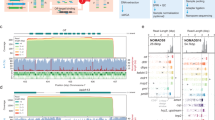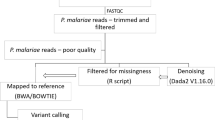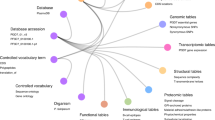Abstract
One goal in sequencing the Plasmodium falciparum genome, the agent of the most lethal form of malaria, is to discover vaccine and drug targets1. However, identifying those targets in a genome in which ∼60% of genes have unknown functions is an enormous challenge. Because the majority of known malaria antigens and drug-resistant genes are highly polymorphic and under various selective pressures2,3,4,5,6, genome-wide analysis for signatures of selection may lead to discovery of new vaccine and drug candidates. Here we surveyed 3,539 P. falciparum genes (∼65% of the predicted genes) for polymorphisms and identified various highly polymorphic loci and genes, some of which encode new antigens that we confirmed using human immune sera. Our collections of genome-wide SNPs (∼65% nonsynonymous) and polymorphic microsatellites and indels provide a high-resolution map (one marker per ∼4 kb) for mapping parasite traits and studying parasite populations. In addition, we report new antigens, providing urgently needed vaccine candidates for disease control.
This is a preview of subscription content, access via your institution
Access options
Subscribe to this journal
Receive 12 print issues and online access
$259.00 per year
only $21.58 per issue
Buy this article
- Purchase on SpringerLink
- Instant access to full article PDF
Prices may be subject to local taxes which are calculated during checkout


Similar content being viewed by others
References
Gardner, M.J. et al. Genome sequence of the human malaria parasite Plasmodium falciparum. Nature 419, 498–511 (2002).
Polley, S.D. & Conway, D.J. Strong diversifying selection on domains of the Plasmodium falciparum apical membrane antigen 1 gene. Genetics 158, 1505–1512 (2001).
Conway, D.J. et al. A principal target of human immunity to malaria identified by molecular population genetic and immunological analyses. Nat. Med. 6, 689–692 (2000).
Volkman, S.K. et al. Excess polymorphisms in genes for membrane proteins in Plasmodium falciparum. Science 298, 216–218 (2002).
Wootton, J.C. et al. Genetic diversity and chloroquine selective sweeps in Plasmodium falciparum. Nature 418, 320–323 (2002).
Roper, C. et al. Intercontinental spread of pyrimethamine–resistant malaria. Science 305, 1124 (2004).
Wellems, T.E., Walker–Jonah, A. & Panton, L.J. Genetic mapping of the chloroquine–resistance locus on Plasmodium falciparum chromosome 7. Proc. Natl. Acad. Sci. USA 88, 3382–3386 (1991).
Su, X.-z., Kirkman, L.A., Fujioka, H. & Wellems, T.E. Complex polymorphisms in an approximately 330 kDa protein are linked to chloroquine–resistant P. falciparum in Southeast Asia and Africa. Cell 91, 593–603 (1997).
Vaidya, A.B. et al. A genetic locus on Plasmodium falciparum chromosome 12 linked to a defect in mosquito–infectivity and male gametogenesis. Mol. Biochem. Parasitol. 69, 65–71 (1995).
Wang, P., Read, M., Sims, P.F. & Hyde, J.E. Sulfadoxine resistance in the human malaria parasite Plasmodium falciparum is determined by mutations in dihydropteroate synthetase and an additional factor associated with folate utilization. Mol. Microbiol. 23, 979–986 (1997).
Mu, J. et al. Recombination hotspots and population structure in Plasmodium falciparum. PLoS Biol. 3, e335 (2005).
Su, X.-z. et al. A genetic map and recombination parameters of the human malaria parasite Plasmodium falciparum. Science 286, 1351–1353 (1999).
Lindblad–Toh, K. et al. Large–scale discovery and genotyping of single–nucleotide polymorphisms in the mouse. Nat. Genet. 24, 381–386 (2000).
Kennedy, G.C. et al. Large–scale genotyping of complex DNA. Nat. Biotechnol. 21, 1233–1237 (2003).
Hardenbol, P. et al. Highly multiplexed molecular inversion probe genotyping: over 10,000 targeted SNPs genotyped in a single tube assay. Genome Res. 15, 269–275 (2005).
Gunderson, K.L., Steemers, F.J., Lee, G., Mendoza, L.G. & Chee, M.S. A genome–wide scalable SNP genotyping assay using microarray technology. Nat. Genet. 37, 549–554 (2005).
Hey, J. Parasite populations: the puzzle of Plasmodium. Curr. Biol. 9, R565–R567 (1999).
Mu, J. et al. Chromosome–wide SNPs reveal an ancient origin for Plasmodium falciparum. Nature 418, 323–326 (2002).
Baum, J., Thomas, A.W. & Conway, D.J. Evidence for diversifying selection on erythrocyte–binding antigens of Plasmodium falciparum and P. vivax. Genetics 163, 1327–1336 (2003).
Baruch, D.I. et al. Cloning the P. falciparum gene encoding PfEMP1, a malarial variant antigen and adherence receptor on the surface of parasitized human erythrocytes. Cell 82, 77–87 (1995).
Su, X.-z. et al. The large diverse gene family var encodes proteins involved in cytoadherence and antigenic variation of Plasmodium falciparum–infected erythrocytes. Cell 82, 89–100 (1995).
Smith, J.D. et al. Switches in expression of Plasmodium falciparum var genes correlate with changes in antigenic and cytoadherent phenotypes of infected erythrocytes. Cell 82, 101–110 (1995).
Trimnell, A. et al. Global genetic diversity and evolution of var genes associated with placental and severe childhood malaria. Mol. Biochem. Parasitol. 148, 169–180 (2006).
Hudson, R.R. & Kaplan, N.L. The coalescent process in models with selection and recombination. Genetics 120, 831–840 (1988).
Nordborg, M., Charlesworth, B. & Charlesworth, D. Increased levels of polymorphism surrounding selectively maintained sites in highly selfing species. Proc. R. Soc. Lond. B 263, 1033–1039 (1996).
Charlesworth, D. Balancing selection and its effects on sequences in nearby genome regions. PLoS Genet. 2, e64 (2006).
Sato, S. & Wilson, R.J. The plastid of Plasmodium spp.: a target for inhibitors. Curr. Top. Microbiol. Immunol. 295, 251–273 (2005).
Kissinger, J.C. et al. The Plasmodium genome database. Nature 419, 490–492 (2002).
Myers, S.R. & Griffiths, R.C. Bounds on the minimum number of recombination events in a sample history. Genetics 163, 375–394 (2003).
Acknowledgements
We thank C. Long and R. Fairhurst for pooled immune human sera and National Institute of Allergy and Infectious Disease (NIAID) intramural editor B.R. Marshall for assistance. This work was supported by the Division of Intramural Research of the NIAID as well as by the US National Institutes of Health, the National Academies Keck Genome Initiative and the Human Frontiers in Science Program (P.A.).
Author information
Authors and Affiliations
Contributions
J.M.: DNA amplification, sequencing and data analysis; J.D.: DNA amplification and sequencing; K.S.: primer design; K.M.M. and J.K.: software and database development and data analysis; G.A.T.M.: manuscript preparation; P.A.: software and database development, data analysis and manuscript preparation; X-z.S.: project design, data analysis and manuscript preparation.
Corresponding authors
Ethics declarations
Competing interests
The authors declare no competing financial interests.
Supplementary information
Supplementary Fig. 1
Distribution of SNPs among 3,539 genes or gene fragments from five P. falciparum isolates. (PDF 3 kb)
Supplementary Fig. 2
Relationship of SNP density and chromosome size. (PDF 4 kb)
Supplementary Fig. 3
Highly polymorphic genes grouped according to GO functional terms. (PDF 68 kb)
Supplementary Fig. 4
Plots of nucleotide polymorphism (Watterson's theta) per gene on the 14 chromosome of Plasmodium falciparum. (PDF 426 kb)
Supplementary Table 1
Genes and sequences surveyed, SNP alleles, and diversity statistics. (XLS 1797 kb)
Supplementary Table 2
DNA sequences and SNPs obtained from 99 worldwide isolates. (PDF 90 kb)
Supplementary Table 3
Chromosomal loci with five or more consecutive polymorphic genes. (PDF 44 kb)
Supplementary Table 4
Polymorphic genes expressed in cell free E. coli rapid translation system. (PDF 137 kb)
Rights and permissions
About this article
Cite this article
Mu, J., Awadalla, P., Duan, J. et al. Genome-wide variation and identification of vaccine targets in the Plasmodium falciparum genome. Nat Genet 39, 126–130 (2007). https://doi.org/10.1038/ng1924
Received:
Accepted:
Published:
Issue date:
DOI: https://doi.org/10.1038/ng1924
This article is cited by
-
Genetic diversity of Plasmodium falciparum AMA-1 antigen from the Northeast Indian state of Tripura and comparison with global sequences: implications for vaccine development
Malaria Journal (2022)
-
Advances and opportunities in malaria population genomics
Nature Reviews Genetics (2021)
-
Genetic diversity of Plasmodium falciparum in Grande Comore Island
Malaria Journal (2020)
-
Self-assembling functional programmable protein array for studying protein–protein interactions in malaria parasites
Malaria Journal (2018)
-
Pooled-DNA sequencing identifies genomic regions of selection in Nigerian isolates of Plasmodium falciparum
Parasites & Vectors (2017)



